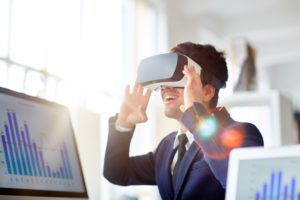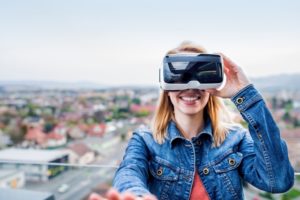Virtual reality (VR) is an interactive computer-generated experience. It comes in both auditory and visual, but also other types of sensory feedback like haptic. Virtual reality is also a way to create a computer-generated environment that immerses the user in a virtual world. When we put on a VR headset, it takes us to a virtual world from the actual surroundings. If you ever have put on one you would know exactly what I am talking about.
What is Virtual Reality?
Virtual reality (VR) means experiencing things through our computers that don’t really exist. When you look at an amazing Canaletto painting, for example, you’re experiencing the sites and sounds of Italy as it was about 250 years ago—so that’s a kind of virtual reality. If you listen to ambient instrumental or classical music with your eyes closed and start dreaming about things. It isn’t an example of virtual reality—an experience of a world that doesn’t really exist? What about losing yourself in a book or a movie? Surely that’s a kind of virtual reality?
Applications of Virtual Reality
You can feel both mentally and physically when you are in the Virtual World. Virtual Reality is essential:
1. Believable:
You will feel like you’re in your real virtual world. This will keep you in believing the real world which will disappear.
2. Interactive:
As you move around, the VR world needs to move with you. You can watch a 3D movie. But it’s not interactive in any sense.
3. Computer-generated:
Why is that important? Only powerful machines, with realistic 3D special effects, are quick enough to create likely, interactive, different worlds that change in a time period as we have a tendency to move around them.
4. Explorable:
A VR world needs to be big and detailed for you to explore. However, a realistic painting shows only one scene from one perspective. A book will describe a huge and complicated “virtual world,” however you’ll be able to only extremely explore it during a linear method, specifically because the author describes it. read value of artificial intelligence in business
5. Immersive:
To be each likely and interactive, VR has to interact both your body and your mind. Paintings by war artists can give us glimpses of conflict. They can convey the sight, sound, smell, taste, and feel. You can play a flight simulator game on your home PC and can be lost in a very realistic, interactive experience for hours. But it’s not playing a real flight simulator, and even less like flying a plane.
How Does Virtual Reality Works?
Consumer VR headsets were first released by video game companies in the early-mid 1990’s. VR isn’t about gaming. But also many other interesting and exciting uses. Education is a prime thing for VR applications. VR has several applications in different fields.
1. It is most commonly used in entertainment applications such as gaming and 3D cinema.
2. It helps students to learn about anatomy and to know the various parts of the human body.
3. VR can help with problems such as depression, post-traumatic stress disorder, and alcoholism.
4. VR has different uses in the military. It is used to train soldiers in a simulated battlefield. This gives soldiers the opportunity to learn without the risk of being killed or injured.
5. VR is used to view the plan of a building. This gives a 3-dimensional image. It saves you a lot of time and even cash for fuel.




